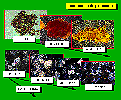
By comparing the mineralogy of the parent rock
with the mineralogy of coarse sands in the soil and analysing
this mineralogy in the different soil horizons, in general, it
is possible to reconstruct how these transformations have taken
place.

Sometimes these transformations are due to
typical edaphic processes. This is the case of the transformation
of gypsum into basanite.
This transformation process often already started in the original
material. This would be the case of transformations of biotite
to chlorite and of feldspars to sericite. On other occasions,
the transformation is totally developed within the initial material.
This is the case of the replacement of calcite by haematite observed
in soils developed on Triassic marls. In other cases, the transformation
starts in the original material and then develops, changing the
direction of the transformation, in the soil. These would be the
cases of the transformations:
